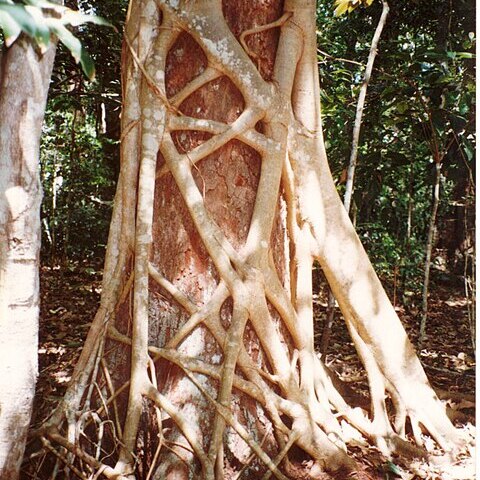Large strangler to 60 m high; trunk to 2 m diam., often widely buttressed. Leaves: lamina usually elliptic, (5–) 7.5–20 (–25) cm long, 2–7 (–10) cm wide, cuneate at base, entire margin, shortly acuminate at apex, glabrous both sides (or underside hairy, fide Cooper & Cooper 2004: 328), shiny, midrib usually yellowish; primary lateral veins 10–16 pairs, not prominent; petiole (2–) 4–7 (–9) cm long; stipules 2.5–7 (–10) cm long, glabrous (red-purple and minutely hairy, fide Cooper & Cooper 2004: 328). Figs paired, lenticellate, ovoid to obloid to ± globular, often with a distinct nipple, 2–4 cm long, 1.5–3.5 cm wide, purplish brown, brownish black or purplish black with paler spots when mature; ostiole strongly mammillate, often to 8 mm long; basal bracts leaving a prominent collar to 1.5 cm diam. at base; peduncle 1–2.5 cm long, c. 0.6 cm diam. Male flowers long-pedicellate; tepals 4. Female and gall flowers sessile; tepals 4, narrowly ovate; style subterminal; stigma obtuse. See also Dixon (2003: 145).
More
A strangler fig which can grow to 60 m tall. It is often 25-35 m high and 15-30 m wide. It is a large tree with a spreading crown. It has strangler roots. The bark is grey and has pustules. The young shoots are bright green. The leaves are simple and 8-25 cm long by 10-15 cm wide. They are smooth. The leaf stalks are 4-7 cm long. The fruit are 20-40 mm long by 15-30 mm wide. They occur singly or in pairs in the axils of leaves. The fruit are dark purple with pale spots. The fruit are edible.


